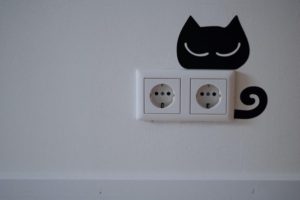

How Does Piggyback Plugs Work?
Piggybacking is common when dealing with electrical outlets, especially where multiple outlets are required. This wiring technique involves jumping from one junction box to another. The technique is safe as long as the maximum amperage per circuit and overall electrical safety at home is maintained.

Piggybacking may also be performed as a standard wiring process when splitting a power source for two different accessories. Here, you'll need a power plug to convert one power outlet into two by plugging in other devices. Power plugs are the removable connectors responsible for supplying electric current from the power source to an electronic device.
Understanding Different Types of Power Plugs
Americord provides different kinds of power plugs for different types of wiring systems. Each plug comes with pins inserted into the outlet to help the electric current travel through insulated wires to the electronic device. They are divided into several categories based on origin and specific power requirements.

Piggyback plugs, also known as switch plugs, are common power plugs used in domestic and industrial wiring. They are a clever and convenient way to switch power to timers or level the alarms at home or office. These plugs are also a perfect solution if your home or office accessories need to be moved or interchanged more often.
How Piggyback Plugs Work
There are various piggyback plugs offered at Americord with varying features and functionalities. We have Piggyback plugs with thermoplastic insulation, piggyback plugs with oil resistance features, and those approved for outdoor use. The plugs come with cords in varying lengths and gauges as the power gauge. Your electrical wiring system will determine the type of Piggyback plug you choose.
The good thing about piggyback plugs is that they are highly customizable to meet your immediate wiring needs. To use them, insert the piggyback plug into the wall and then plug your device into the female end. Switch to ''closed'' to allow power to pass through one blade of the piggyback power plug.

One key benefit of a piggyback plug is that you can unplug the cords from the walls and keep them separated without losing the benefit of a split power source. This is also one way of testing the pump by itself. However, efficient handling of piggyback plugs and any piggyback wiring procedure requires knowledge of how electrical outlets work.
Installing a Piggyback Plug from a Float Switch
Like any other person with power utilization needs at home, purchasing a float switch with a piggyback plug is a wonderful idea to increase power use efficiency. However, piggyback wiring may be a delicate process if you don't have the required knowledge.
For experts, installing a float switch with a piggyback plug is very simple. All you have to do is plug the float switch into a power outlet, and plug the pump into the piggyback outlet on the back end of the float. For starters, here are a few simple steps to guide you through the process;
- Switch off the power outlet at the main electrical panel.
This is a standard procedure for safety when handling any wiring at home or office. It helps avoid unnecessary accidents.
2. Remove the screws securing the cover plate on the existing switch.
This is to loosen the entire electrical panel for an easy installation process. A simple screwdriver will help you remove the screws.
3. Dismantle the Outlet
Dismantling the outlet first happens after you've removed the two screws holding the existing outlet. After that, you'll need to get into the junction box and pull out the outlet from there.
4. Fix the wire into the box
Remove the insulation from the new float, locate the two new screws on the fixture, and loosen them with a screwdriver. Afterward, slide back the black float wire into the brass-colored screw. Keep the white wire under the silver screw and the bare wire to the green ground screw near the junction box. Tighten the three wires and secure them in place.
5. Slide the Wires into the Junction Box
After tightening the wires, push them and the outlet back into the junction box. Finalize by screwing the outlet back to the junction box. Route your new float switch with a piggyback plug as needed.

Piggyback plugs are necessary to operate pump switches. In most cases, the lack of one affects the entire functionality of the pump. But if you choose to operate without one, ensure your pump is hard-wired.
Final Thoughts
Piggyback plugs are an efficient way to utilize power usage at home. You can effectively use them as a switch plug or a momentary footswitch at home or office. If you're seeking to use them at home, consider the Piggyback plugs at Americord. These are UL/CSA approved and suit different industrial and domestic needs. Their efficiency also allows them to serve in an outdoor environment.
